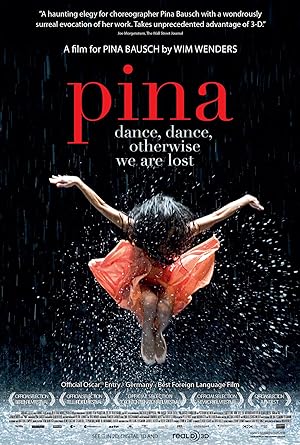Pina ended up in my queue because Pina was listed as one of the top twenty-five documentaries ever made, and I love dance. I didn’t know of Pina Bausch’s existence before watching Wim Wenders’ Pina. I did not do any research about the making of the documentary until after I watched Pina. I did not know that Wenders conceived of making Pina before Bausch died suddenly and almost cancelled filming it, but the dancers persuaded Wenders to still make the documentary. Many of the dances featured in Pina were never danced without Bausch being present or being featured in the dance. I did not know it was originally shot in 3D and saw it at home on my 30 something inch flat screen tv.
Pina is not a PBS style documentary. Pina will not give you a comprehensive, linear narrative with excerpts of dances interspersed among the talking heads to explain the meaning and significance of Bausch’s work in contemporary dance. Pina demands that the viewer experience the work for his or herself and give his or her complete attention.
Pina is primarily a film that privileges the performance with occasional glimpses at the souls of those who create the beauty. Fragments of notable dances are shown on stage, in nature or in the streets. There are occasional voiceovers from the dancers about their experiences with Bausch that are played over the dancer performing or somber close ups of them sitting still. The sets, whether organic or staged, are breathtaking and ambitious in how they play as essential a role as the dancers.
I loved Pina and would love to see it again on the big screen in 3D if possible. Just watching Pina in my living room was pretty captivating and dare I say preferable to a real life performance because I am not often so aware of the dancer’s breath and strain in executing a piece. Wenders’ filming perspective gives the viewer more than what you get in real life when you are in a seat in the audience and a predetermined distance from the stage. Wenders’ Pina insures that your eye will focus and notice more as a novice consumer than if you were in the theater. Pina was imbued with so much emotion as a living memorial to Bausch and every dancer still living. One dancer remarked that Bausch watched her more than her parents did during her entire childhood, which I did not take as a swipe at her parents’ negligence, but rather as a testament to Bausch’s devotion and the intensely intimate relationship between each dancer and the choreographer. Pina implies that dancing for Bausch was a lifetime commitment as sacred as any marriage vow.
My mother did not like Pina. She did not like being thrown in the middle of the action without any explanation and left to draw her own conclusions. She even fell asleep. I honestly have no idea how anyone can’t be amazed or touched by the performances. Come on, there is a miniature waterfall on stage! Pina is a must see for dance lovers unless you don’t like documentaries that do not explicitly guide your experience with narration.
Stay In The Know
Join my mailing list to get updates about recent reviews, upcoming speaking engagements, and film news.





